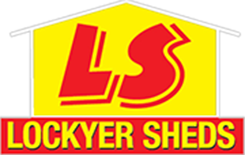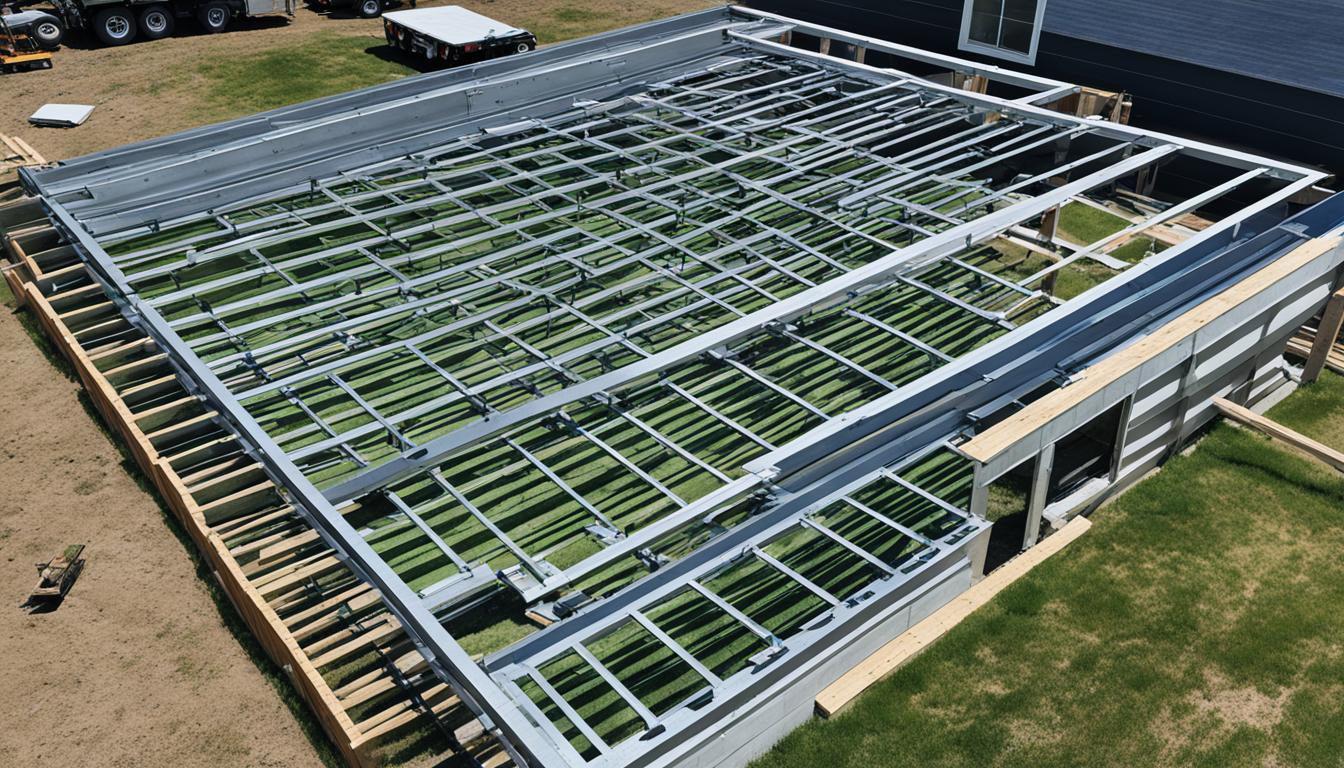Is your space too cluttered with not enough storage? It’s time to make the most of your backyard. We will guide you through building that perfect shed. From DIY sheds Brisbane to backyard shed plans Melbourne, you’ll learn everything you need for shed construction in Australia.
This guide is for everyone. Whether you love DIY projects or it’s your first time, you’ll have all you need. You can build flat pack sheds Sydney, steel shed kits Perth, or build a Colorbond shed. We have the shed assembly instructions and tips for you. Soon you’ll have the perfect outdoor storage solutions for your space.
Lockyer Sheds is here to help. They provide custom shed solutions in several areas of Australia including Toowoomba, Gatton, and more. With this guide, you can unlock your backyard’s potential. Take the first step to a shed that’s functional, sturdy, and looks great. It’ll be a space you’ll enjoy for years to come.
Understanding the Basics of Shed Construction
Building a shed needs careful planning. You might want a spot for outdoor storage or a place to work. It’s key to know the basics for a good end result.
Choosing the Right Shed Type
Start by picking the right shed for your wants. You can choose from classic timber backyard shed plans Melbourne to new steel shed kits Perth or tough Colorbond sheds. Each has its own benefits.
Wooden sheds have a cosy look and are budget-friendly. Meanwhile, steel and Colorbond sheds last longer and need less care. Consider what suits your needs best.
Site Preparation and Planning
Getting the site ready matters a lot. Check the ground, how water flows, and if it’s easy to get to. You also need to get any permits and follow the local rules.
Make a detailed plan with sizes, materials, and how to build it. This makes the whole process smoother.
Essential Tools and Materials
The right tools and materials are a must. Buy or rent the tools you’ll need. And pick up the wood, roof stuff, and outer walls from a trusty quality shed suppliers.
It’s vital to know about each item so you can pick well.
Know the building basics, site preparation, planning, and getting tools and materials. That way, you’re ready to start your shed project with confidence.
Step-by-step shed construction Australia
Building a shed in Australia takes thoughtful planning. In order to be strong and practical, it’s key to follow each step. This is true whether you love doing things yourself or are working with experts.
Laying the Foundation
A strong foundation is crucial for any shed. You need to prepare the site well, which includes digging and leveling the ground. Depending on your area and the soil, you can pick the best foundation type.
- Concrete slab: Strong and not needing much upkeep, but can cost more.
- Piers: Great for uneven ground because they let air pass through.
- Timber base: A cheaper choice, good for smaller sheds.
Remember, no matter what you choose, your foundation should be flat, well-drained, and follow the rules in your area.
Framing the Structure
After your foundation is ready, it’s time to build the frame. This part is vital for the shed’s durability. You can build it from scratch or use a kit, which has benefits of its own.
When making the frame, be careful with the wood you pick and how you cut it. Make sure everything is put together well and strong. Include walls, doors, windows, and supports to make your shed safe and meet the local rules.
Installing the Roof
The roof keeps your shed safe from the weather and makes it last longer. You can choose different roof styles and materials. Think about using metal, shingles, or Colorbond.
It’s very important to set up the roof right to avoid leaks and dampness. Also, make sure there’s enough air coming in to stop mold.
By sticking to these construction steps, you’ll create a shed with a strong roof. It will also look good as part of your DIY project in Brisbane.
Cladding and Exterior Finishes
Choosing the right cladding for your building a Colorbond shed is key. It affects its look, how well it stands the test of time, and its upkeep. Options range from classic timber to high-tech vinyl and metal types. Each one has its own perks. This guide will help you pick the best one for your needs.
Choosing the Right Cladding Material
For a steel shed kits Perth, consider the weather, how much effort you want to put in for maintenance, and your taste. Timber looks warm and inviting but needs care to keep it looking good. It must also be protected from moisture and pests. Vinyl, though, is easy to look after and lasts a long time but might not look as natural as timber.
Metal, like Colorbond, offers a sleek, modern look and is very durable. Colorbond sheds are tough against the weather and come in lots of colours. This makes them a stylish pick. Metal sheds, like flat pack sheds Sydney, also keep pests like termites out, which means they last longer.
Applying Exterior Finishes
After you’ve cladded your shed, it’s time to add some flair with exterior finishes. These not only beautify but also protect your shed.
Dress it up with paint, stain, or sealants. A new coat of paint brings life to a timber shed, while a stain showcases the wood’s natural beauty. These options protect your cladding, too.
But before you finish, prep the surface well. Clean, sand, and prime for the best results. To make it last longer, consider clear sealants or UV treatments to stop your finish from wearing out too soon.
Don’t forget the little details like trim or shutters. They bring your shed’s look together. Plus, they can make your shed more practical, adding things like extra light and airflow.
Customizing Your Shed
After finishing the build of your shed, it’s time to make it your own. You may use it as a place to work, enjoy hobbies, or store your goods. Making the shed fit your needs will make it work better for you.
Adding Windows and Ventilation
Windows and good airflow are key to a shed that’s welcoming and bright. Look into different windows that let in light and fresh air, reducing dampness. This makes your Step-by-step shed construction Australia project a better place to be.
For Brisbane DIY sheds, adding vents, fans, or louvres is a great idea for air circulation. This keeps your shed cool and fresh, no matter the season.
Organizing Your Shed Interior
Now that the basics are done, let’s organize inside. Use shelves, pegboards, and systems to sort your tools. This keeps everything in its place and easy to find.
Look into using the space above or on walls for storage. This makes your shed feel bigger and more organized. Don’t forget to add lights and outlets. They make working in the shed a lot easier.
Adding these personal touches will make your shed perfect for your needs, whether it’s for storage, making things, or just hanging out.
Obtaining Permits and Regulations
Building a backyard shed in Melbourne or setting up a flat pack shed in Sydney means knowing the rules. It’s key to understand what’s needed before you start. Each area has its own rules on size, use, and where you place the shed.
To start, many places require a permit for a shed over a certain size. Also, if it’s going to be used for anything special like storing dangerous stuff or for a business. Getting this permit involves showing detailed plans, paying fees, and having the shed checked to make sure it’s safe and legal.
- Know the rules about where structures can be on your land.
- Talk to the local government to see what permits you need.
- Make detailed plans including size, materials, and how you’ll use it.
- Give the proper paperwork and pay fees.
- Have the shed checked during and after you build it.
Following these rules is really important. It can save you from fines and legal problems with your backyard shed plans in Melbourne or flat pack shed installation in Sydney. Not getting the right permits or breaking the rules can be very expensive and might mean you have to take your shed down.
Working with Professional Shed Builders
Building a shed on your own is rewarding, but hiring a shed erection guide can be better. They bring a lot of knowledge in design and building. This makes the process smoother and worry-free.
Benefits of Hiring a Professional
Letting a shed builder handle your project has many pluses. For instance, it saves you time. You can then focus on other important things while they work.
- Experienced builders ensure high quality. They know how to put together durable sheds like steel shed kits Perth or building a Colorbond shed well.
- They keep up with the rules. This means your shed will meet all the necessary building standards and permits.
- Even though hiring them might cost more at first, it often saves money. Their skills can avoid expensive errors. Plus, they use materials efficiently.
Selecting a Reputable Contractor
Picking the right shed builder is crucial. Start by looking into their background. Check their qualifications, licenses, and what other clients say. Get clear quotes and read the contract closely to match it with your needs.
Good communication is vital. Make sure your needs and any special situations are clear from the start. A skilled shed builder will team up with you for an easy building experience. They’ll create a shed that fits your needs perfectly.
Maintaining and Protecting Your Shed
Building a shed in Australia is a big deal. To keep it in top shape, regular checks and clean-ups are key. This helps protect your DIY sheds Brisbane or backyard shed plans Melbourne from bad weather and pests.
Regular Cleaning and Inspection
For your flat pack sheds Sydney or steel shed kits Perth, staying clean is a must. A routine that includes:
- Clearing debris and vegetation from the shed’s exterior and surrounding areas
- Checking for signs of rust, rot, or structural damage, and addressing any issues promptly
- Inspecting the roof, cladding, and foundation for any leaks or cracks
- Cleaning the inside to keep it dry and tidy
Following a maintenance plan helps spot and fix issues early. This makes sure your shed lasts a long time.
Weatherproofing and Pest Control
Sheds in Australia face many challenges due to the local climate and wildlife. It’s important to keep them weatherproofed and pest-free. Try these methods:
- Use caulk and weather stripping to seal gaps. This keeps moisture out and your shed well-insulated.
- Apply coatings and sealants outside your shed. They protect against the sun, rain, and pests.
- Put up screens or use repellents to keep pests away.
- Regularly look out for pest clues, like droppings or damage. Catching issues early helps avoid big problems.
These steps help your shed withstand the weather and keep pests at bay. This ensures it’s a safe and long-lasting space for your needs.
Shed Construction in Different Australian Regions
Australia has diverse landscapes, offering unique challenges for shed building. Coastal places need sheds that can handle salty air and strong winds. Local guides suggest using materials that don’t rust and strong foundations. Areas at risk of cyclones also need extra-strong sheds to stay safe during bad storms.
In bushfire zones, sheds must use fire-resistant materials and follow strict rules. Choosing the right site and managing nearby plants well is key. In dry regions, sheds should be well-insulated and ventilated to protect what’s inside from extreme heat.
It’s vital to work with locals and professionals when building sheds in these areas. They can help you choose the best materials and designs for your shed. This ensures it will last and be safe, no matter where in Australia it’s built.

